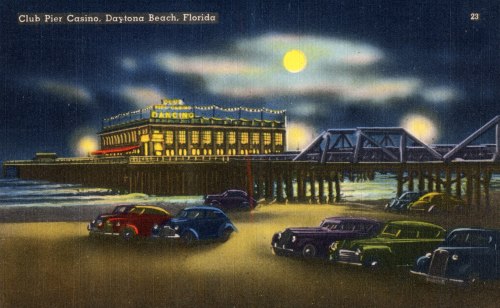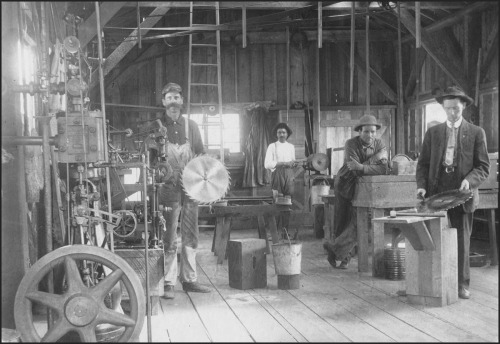#florida history
A collection of early Kodak snapshots of western Florida taken by amateur photographer Joseph John Kirkbride in 1889 and 1890.
Source: Library of Congress.
Weekee Watchee, where at one point in the 60s, there was a giant fiberglass beetle on display.
Post link
Today’s post comes from Angie Neely-Sardon, who is the Reference Librarian/Instructor for the Mueller Campus of Indian River State College and former Computer Services Librarian for Bruton Memorial Library in Plant City, FL.

Above: Quintilla Geer Bruton (L) holds the State Library Award for 1963. Image used with permission from Plant City Photo Archives.
Quintilla Geer Bruton was born in 1907 in Walton, Kentucky. She moved to Plant City, FL, with her parents and sister on Thanksgiving Day, 1923. She was the valedictorian at Plant City High School for the Class of 1926. She attended Tampa Business College and Brewster Vocational School, both in Tampa, FL. She married her high school classmate, James D. Bruton, Jr. in 1932. The couple made their home in Plant City where they accomplished much for the community. Quintilla’s pioneering role in creating a public library for Plant City led her to be affectionately known as “The Library Lady.”
Quintilla Geer Bruton’s contributions to libraries, archives, and local history are still felt and appreciated in Plant City, Hillsborough County, and throughout Florida today. Bruton was instrumental in founding the community’s public library. The Plant City Woman’s Club held their meetings in the Miller House in Plant City. From 1927 to 1959, the volunteers gathered books and ran a community library from their meeting space where residents could check out items for a fee. The city government contributed $25 per month beginning in 1940. In 1959, the library space in the Plant City Woman’s Club facility became infested by termites and needed to be destroyed. The Plant City Woman’s Club, and Quintilla Geer Bruton in particular, were not satisfied with the space, collections, and services currently being provided to the residents in lieu of a proper, municipal library. Bruton launched a movement within the community for a government-funded, public library. In response, the city commission held an election to determine if the residents of Plant City supported a new tax to fund the creation of a municipal library. The residents voted to tax themselves in exchange for a public library, those in favor winning nearly 75% of the votes with 551 votes for and 190 votes against.
The Plant City Woman’s Club meeting site was torn down after 2,000 volumes were retained for the new library space. The Plant City Public Library was built on the same site and opened in 1960. Bruton was the 1961 winner of the annual Outstanding City of Plant City Award. The Plant City Public Library flourished. During only its third year in existence, the Library won the award for Florida’s Most Outstanding Public Library from the Book-of-the-Month Club and the Dorothy Canfield Fisher Award.
Quintilla Geer Bruton made a great contribution to the history of the Plant City area. She co-wrote the book “Plant City: Its Origin and History” with David E. Bailey. The book, published in 1985, details the history of Plant City through to 1976. Bruton was passionate about local history and preservation. She volunteered with the Daughters of the American Revolution, the East Hillsborough Historical Society, and the Community Archives Center, the latter of which is now named in her honor.
Quintilla Geer Bruton died on January 4, 1989. The Plant City Public Library was renamed the Quintilla Geer Bruton Library from 1990-1994. Her husband continued her work after her death and donated funds to support the library. In 1994, the library was renamed the Bruton Memorial Library to honor both Quintilla Geer Bruton and her husband, Judge James D. Bruton, Jr.
On this date in 1822, the U.S. Congress merged the recently seized territories of East Florida and West Florida into the Florida Territory. The region would later become the U.S.’s 27th state on March 3, 1845.
Much, much later, on May 29, 1941, the state would become home to the Club Pier Casino in Daytona Beach. This undated postcard described the pier as having been” famous a decade for fishing, now a Public Club Casino. Dining, Dancing, etc., it is still an Angler’s Paradise”.
This postcard comes from Hagley Library’s collection of Postcards of motels, roadside attractions, restaurants, etc. in the United States (Accession 2007.214). This collection comprises 130 postcards dating from approximately 1930 to 1960. The postcards depict motels (including motor courts and cabins), restaurants, roadside attractions, and scenic views from across the United States. To view it online now, click here.
Post link
Today’s #WorkerWednesday post brings us inside the tool room of the Hoopes Brothers & Darlington sawmill in Brooksville, Florida. A note on the reverse of this ca. 1907 photograph identifies the person on the far right as Frank Orville Reagan (1869-1937), the son of Owen Wily Reagan (1847-1909), the sawmill’s manager.
The company that owned the mill, Hoopes Brothers & Darlington, began in West Chester, Pennsylvania in 1867 as a manufacturer of wooden spokes for wheels. By the 1880s it had become one of the largest wooden wheel makers in the United States, with mills and timber harvesting operations established throughout the southern United States.
The mill seen here was established in 1906. Hoopes Brothers & Darlington had originally established their Florida operations in nearby Ocala in 1899, but relocated after exhausting local timber supplies and to take advantage of cheaper railroad freight rates. Owen Wiley Reagan had also managed the Ocala mill, with his son Frank working as assistant manager. After his father’s death in November 1909, Frank took over operations of the Brooksville mill.
This photograph is part of Hagley Library’s collection of Hoopes Brothers & Darlington, Inc. photographs (Accession 1969.099). This collection consists of miscellaneous images from the company, largely dating between 1900 and 1948, as well as advertising material and letterheads. To view the collection online now in our Digital Archive, click here.
Post link



